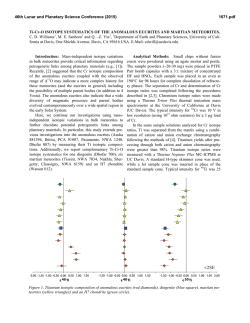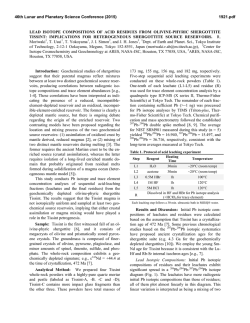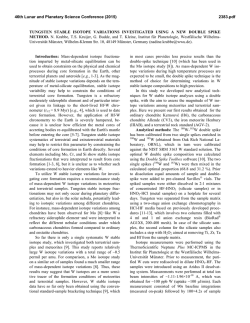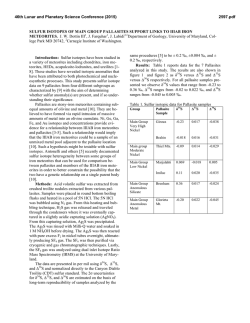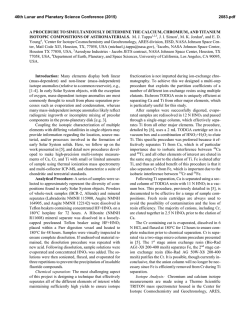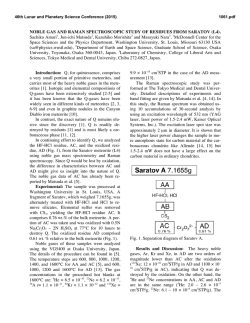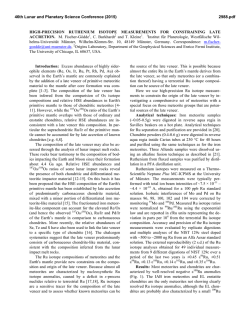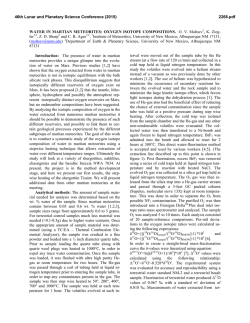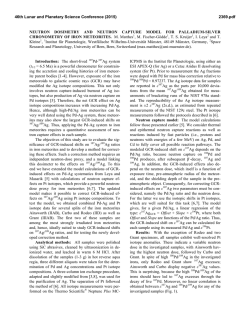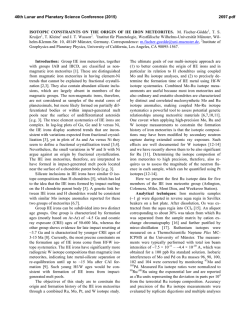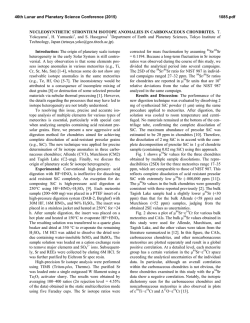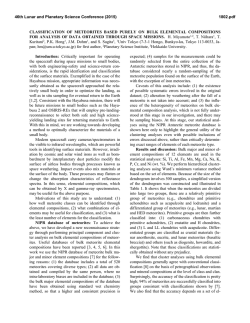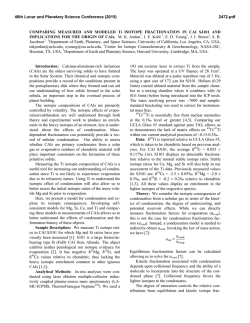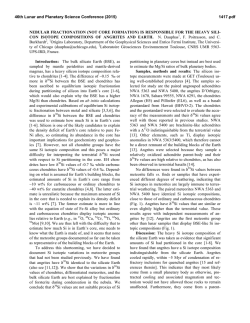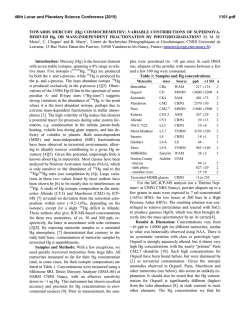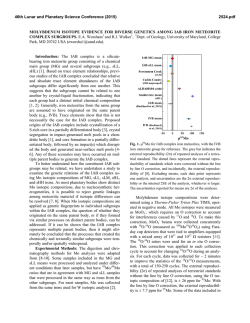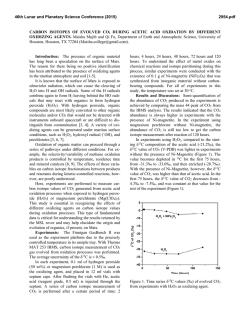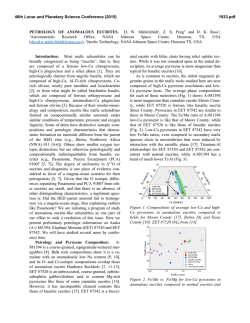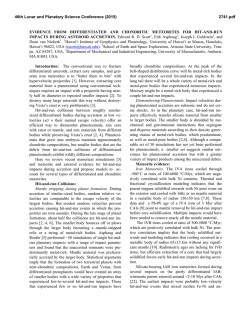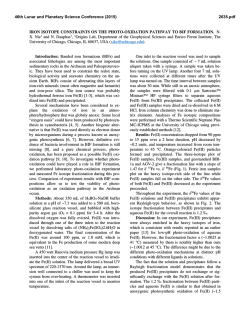
Refinement of the Mo-Ru Isotope Cosmic Correlation Using High
46th Lunar and Planetary Science Conference (2015) 1588.pdf REFINEMENT OF THE Mo-Ru ISOTOPE COSMIC CORRELATION USING HIGH PRECISION Mo AND Ru ISOTOPE DATA. K. R. Bermingham1, R. J. Walker1, and E. A. Worsham1, 1Department of Geology, University of Maryland, College Park, Maryland, 20742, USA ([email protected]). Introduction: One way to examine the genetic make-up of Earth’s building blocks is by comparing the isotopic compositions of certain elements in terrestrial rocks with the compositions of those same elements in cosmochemical materials that may have contributed to the construction of the planet. This approach is viable because a number of studies have documented wellresolved mass-independent isotope anomalies, here termed nucleosynthetic anomalies, for a variety of elements in a range of whole rock meteorites (e.g., Ca [1], Ti [2], Cr [3], Zr [4], Mo [5, 6], Ru [7], Ba [8], Nd [9], and Sm [10]). These elements, therefore, can serve as genetic tracers. Nevertheless, the relative contributions of diverse materials to the building blocks of Earth during different stages of its construction remain poorly constrained. The highly siderophile element (HSE) Ru is a powerful tool for addressing terrestrial genetics. Wellresolved mass-independent 100Ru isotope anomalies have been identified in different iron, stony-iron, and stony whole rock meteorites [7]. It is likely that the HSE composition of the silicate Earth was established as a result of several large impacts during the final ~0.5% of Earth’s accretion (e.g., late accretion [11,12]). The Ru isotopic composition of the mantle, therefore, likely records the genetic make-up of the final substantial building blocks of Earth. Well-resolved mass-independent Mo isotope anomalies have also been identified in iron, stony-iron, and stony whole rock meteorites [5,6]. In contrast to the HSE, it is likely that the abundances of the MSE were predominately established by high pressure metalsilicate partitioning during the final ~10% of terrestrial accretion [5,11,13]. The Mo and Ru budgets of the terrestrial mantle were, therefore, likely established at different stages of planetary accretion, and coupling Ru and Mo isotopic data can, therefore, potentially lead to new insights to the identity of materials added to planetary mantles during two stages of terrestrial accretion [5,13]. Comparison of Ru and Mo isotopic compositions of different whole rock meteorites led to the recognition of a cosmochemical linear trend, with Earth plotting at one end of the correlation [14]. The fact the Earth plots on this Mo-Ru cosmic correlation is noteworthy. It suggests that the genetics of materials added to the Earth during the last ~10 % and ~0.5 % of accretion was the same [14]. Otherwise, differing genetics of the Mo and Ru should have led to Earth plotting off of the correlation. Further, the observation that Earth plots at one end of the trend suggests the final building blocks of Earth were dominated by materials that genetically differed from most known cosmochemical reservoirs. Despite the important implications of the Mo-Ru cosmic correlation, the trend has been constructed using group averages for a limited number of meteorites [5-7]. Further, the Ru and Mo isotope compositions used to define this relationship have not been collected from the same pieces of meteorite. Finally, although isotope compositions of meteorites from the same group should be identical if they formed from the same genetic reservoir, the number of data supporting this supposition is very limited. Within-group heterogeneity could result from analytical issues, unaccounted for cosmogenic effects, or even inaccurately grouped meteorites. Consequently, the precise relationship between the Mo and Ru isotopic compositions in select meteorites should be further refined with higher precision data. Another significant question is whether or not bulk silicate Earth possesses a homogeneous Ru isotopic composition. If a significant proportion of the HSE added during late accretion was isotopically heterogeneous, it is plausible that some portions of the early mantle were characterized by Ru isotopic heterogeneity. This scenario coupled with 182W [15] evidence for a poorly mixing mantle during early Earth history leads to the possibility that early Earth rocks may provide evidence for Ru isotopic heterogeneity and possibly a genetic fingerprint for diverse terrestrial HSE contributors. In light of these questions, we have developed analytical methods using negative thermal ionization mass spectrometry (N-TIMS) to obtain high precision ≤10 ppm (2SD external precision of standards) Ru [16] and Mo isotope data. With the capability to achieve higher precision than previously reported, we now have the ability to refine the Mo-Ru cosmic correlation. Here, we report preliminary findings on Ru and Mo isotope data from grouped irons. Methods: Materials analyzed comprise 0.5 – 2 g pieces of grouped and ungrouped iron meteorites. Samples were cut using a diamond blade using distilled water as a lubricant. Samples were sanded using silicon carbide sandpaper and sonicated before digestion in 8M HCl. Complete dissolution of all samples was achieved after 48 hrs at 120ºC. After dissolution, the solution was divided into aliquots for Ru and Mo isola- 46th Lunar and Planetary Science Conference (2015) tion and purification. Ruthenium was isolated from the matrix using a cation exchange column followed by purification via microdistillation. Molybdenum was isolated from the matrix using a cation column and then purified via two stages of anion exchange chromatography. The Mo and Ru isotope compositions were measured using a Thermo Fisher Triton Plus TIMS operated in negative mode at the Department of Geology, University of Maryland. Oxygen isotope compositions were measured using 1012 ohm resistors, enabling accurate corrections for in-run oxygen isotope variations and oxide interferences. This correction is critical because our initial study indicated significant variations in O isotopic composition from run to run, and during the course of a run. The method used here utilizes baseline measurement times of 21 minutes, thereby improving accuracy of baseline measurements for the 1012 ohm measurements. Integration times of ~2 minutes are used to improve the signal/noise during data collection when using 1012 ohm resistors. Between 200 and 250 cycles are measured per run with 15s between block idle time. Replicate analyses of an Alfa Aesar Ru standard (n=12) indicate an external precision of ±10.9 ppm (2σ SD) for 100Ru/101Ru. Replicate analyses of an Alfa Aesar Mo standard (n=5) indicate an external precision of ±8.60 ppm (2σ SD) for 95 Mo/96Mo. Data are corrected for instrumental mass fractionation using the exponential law and 99Ru/101Ru or 98Mo/96Mo as the normalizing ratio. Results: The Ru isotope composition of meteorites from the IIAB, IVA, IVB, and one ungrouped iron meteorite (Chinga) display well resolved negative 100 Ru isotope anomalies (Fig. 1a). There are no resolvable isotope variations from the standard in 96Ru/101Ru, 98 Ru/101Ru, 102Ru/101Ru 104Ru/101Ru. These results are in agreement with published work [7,17] which have been previously interpreted to indicate either an r-process excess or s-process deficit as the source of Ru isotope variations. No resolved anomalies have been identified yet in terrestrial samples (Fig. 1b). Molybdenum isotope compositional data for the same samples from the IIAB and the IVB are reported here and show variations in 92Mo, 94Mo, 95Mo, 97Mo, and 100Mo. Both of these groups show positive anomalies, up to ~+200 ppm in 92Mo in group IVB and ~+100 ppm in 92Mo in group IIAB. These results are in agreement with previously published data [5,6] and have been interpreted to indicate s-process deficits [6]. Discussion: In Fig. 2, the 95Mo and 100Ru isotope compositions collected here are plotted alongside meteorite group averages reported in [6,7]. The negative correlation between these isotopes is also evident in data reported from our study. However, there is a small 1588.pdf resolvable offset in North Chile (IIAB) from the trend. We are currently extending the database to include thermally unequilibrated samples and ungrouped irons. Acknowledgements: We thank the Smithsonian National Museum of Natural History for generously providing samples for this study. (a) (b) Fig. 1. (a) 100Ru composition different iron meteorites. (b) 100Ru isotope data from chromitites (C1, C2, C3) from the 492 Ma Shetland ophilite complex [16]. Data points are single measurements of each sample. Error bars represent the 2 s.e. internal error associated with a single measurement. The 2σ SD external precision (indicate by the dotted lines) for the analytical period as determined by repeated measurement of an Alfa Aesar Ru standard. Earth Fig. 2. The Mo-Ru cosmic correlation: The 100Ru and 95Mo composition iron meteorites from this study (triangles) and group averages from published work (circles, [5-7]). Star represents Earth. Data are in ppm. Error bars for triangles represent the 2 s.e. internal error associated with a single measurement. Error bars for the circles represent the average error reported in [5-7]. References: [1] Dauphas N. et al. (2014) Geochim. Cosmochim. Acta, 407, 96-108. [2] Trinquier A. et al. (2009) Science, 324, 374-376. [3] Qin L. et al., (2010) Geochim. Cosmochim. Acta, 74, 1122-1145. [4] Akram W. et al. (2013) Ap. J., 777, 169-181. [5] Dauphas et al., Ap. J., 569, L139-L142; [6] Burkhardt C. et al., Geochim. Cosmochim. Acta, 312, 390-400. [7] Chen J. et al. (2010) Geochim. Cosmochim. Acta, 74, 3851-3862. [8] Carlson R.W. et al. (2007) Science, 316, 1175-1178. [9] Boyet M. and Gannoun A. (2013) Geochim. Cosmochim. Acta, 121, 652-666. [10] Andreasen R. et al., (2006) Science, 314, 806-809. [11] Li J. and Agee C.B. (2001) Geochim. Cosmochim. Acta, 65, 1821-1832. [12] Bottke W. et al. (2010) Science, 330, 1527-1530. [13] Dauphas N. et al. (2002) Geophys. Res. Lett. 29, 1084. [14] Dauphas N. et al., (2004) Earth and Planet. Sci. Lett. 226. 465-475. [15] Touboul M. et al. (2012) Science 335, 1065-1069. [16] Bermingham K.R. et al. (2014) Goldschmidt Conference, Sacramento USA, p183. [17] Fischer-Gödde et al. (2012) LPS XLIII, Abstract #2492.
© Copyright 2026
